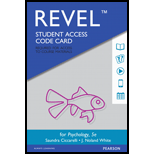
Eyes help to see and view different objects by forming the image on the retina, a part of eye serves as a screen for the purpose of image formation. The retina detects light and generates action potential within optic nerves. The photoreceptor cells are the rods and cones cells. These are present at the rear side of the retina.
Rods and cones both are the parts of retina in the eyes that contain membranes packed among photopigments molecules that absorb light and initiate photoreception process. The blind spot is a small spot in the visual field of two eyes, which corresponds to the optic disk’s position in the retina. Optic disk does not have any photoreceptors. The blind spot does not contain any photoreceptor, thus focused image cannot be seen.
Want to see the full answer?
Check out a sample textbook solution
Chapter 3 Solutions
Psychology
- what is it like to be in the Dharma center of worship massachusetts? what was the most interesting thing?how does this place help your better understanding of religious practices?arrow_forwardDescribe the interior decoration in detail of the dharma center in Cambridge massachusetts.arrow_forwardCan you help me find 20 research peer review article on psychology evolutinary&cultural that has do with indiaarrow_forward
- Can you help me find 20 peer review article on psychology evolutinary&cultural that has do with indiaarrow_forwardIntroduction: An open question is a question that cannot be answered 'yes or no. Instructions: As you relate to the content for this week of Jazz, think of an open question you could ask yourself and try to elaborate a brief open response in 150 words. Your question can relate to anything about jazz, directly or indirectly.arrow_forwardIntroduction: An open question is a question that cannot be answered 'yes or no. Instructions: As you relate to the content for this week, A History of Jazz, think of an open question you could ask yourself and try to elaborate a brief open response in 150 words. Your question can relate to anything about jazz, directly or indirectly.arrow_forward
- can you make me a a spps box plot that has all the data 1- through 67 that has age,ethencity, person 2 is person attractive with tattoss and queston 13 is attractive without tattoosarrow_forwardI need you to make a box plot on SPSS using age, ethnicity, person 2 is people attractive with tatoos an person 13 is people attractive without tattosarrow_forwardCan you help me find 20 peer review article on psychology evolutinary&culturalarrow_forward
- Does this article have to do with evolutionary psychology & cultural https://www.cambridge.org/core/journals/ageing-and-society/article/views-and-experiences-of-adult-children-concerning-intergenerational-relationships-with-their-older-kin-a-qualitative-study-from-south-india/F71A9BA3F3FB27D16CE589E8885CFB53arrow_forwardWhat should the role of a school counselor be as it applies to Section 504 of the Rehabilitation Act of 1973? Write in a narrative format and include in the in-text citations of the following source: “American School Counselor Association. (2024). The school counselor and Section 504 plan and process. https://www.schoolcounselor.org/Standards-Positions/Position-Statements/ASCA-Position-Statements/The-School-Counselor-and-Section-504-Plan-and-Proc “arrow_forwardWhat role do you think social media has on the occurrence of domestic violencearrow_forward
 Ciccarelli: Psychology_5 (5th Edition)PsychologyISBN:9780134477961Author:Saundra K. Ciccarelli, J. Noland WhitePublisher:PEARSON
Ciccarelli: Psychology_5 (5th Edition)PsychologyISBN:9780134477961Author:Saundra K. Ciccarelli, J. Noland WhitePublisher:PEARSON Cognitive PsychologyPsychologyISBN:9781337408271Author:Goldstein, E. Bruce.Publisher:Cengage Learning,
Cognitive PsychologyPsychologyISBN:9781337408271Author:Goldstein, E. Bruce.Publisher:Cengage Learning, Introduction to Psychology: Gateways to Mind and ...PsychologyISBN:9781337565691Author:Dennis Coon, John O. Mitterer, Tanya S. MartiniPublisher:Cengage Learning
Introduction to Psychology: Gateways to Mind and ...PsychologyISBN:9781337565691Author:Dennis Coon, John O. Mitterer, Tanya S. MartiniPublisher:Cengage Learning Psychology in Your Life (Second Edition)PsychologyISBN:9780393265156Author:Sarah Grison, Michael GazzanigaPublisher:W. W. Norton & Company
Psychology in Your Life (Second Edition)PsychologyISBN:9780393265156Author:Sarah Grison, Michael GazzanigaPublisher:W. W. Norton & Company Cognitive Psychology: Connecting Mind, Research a...PsychologyISBN:9781285763880Author:E. Bruce GoldsteinPublisher:Cengage Learning
Cognitive Psychology: Connecting Mind, Research a...PsychologyISBN:9781285763880Author:E. Bruce GoldsteinPublisher:Cengage Learning Theories of Personality (MindTap Course List)PsychologyISBN:9781305652958Author:Duane P. Schultz, Sydney Ellen SchultzPublisher:Cengage Learning
Theories of Personality (MindTap Course List)PsychologyISBN:9781305652958Author:Duane P. Schultz, Sydney Ellen SchultzPublisher:Cengage Learning





